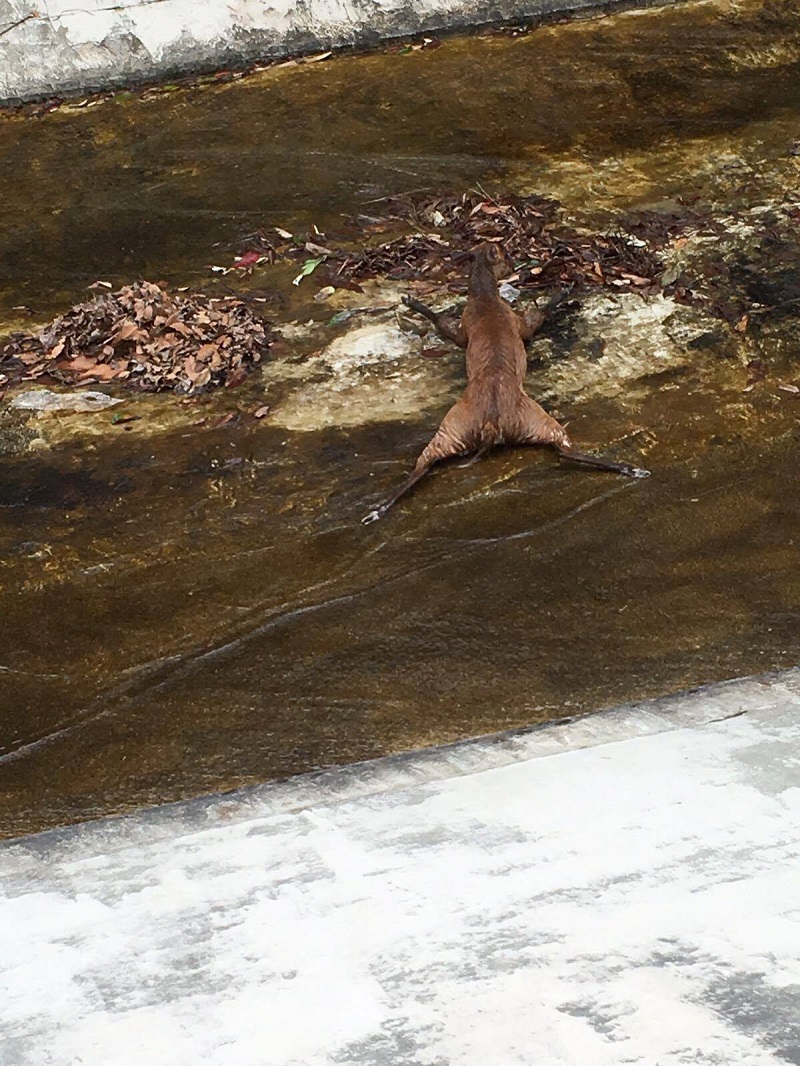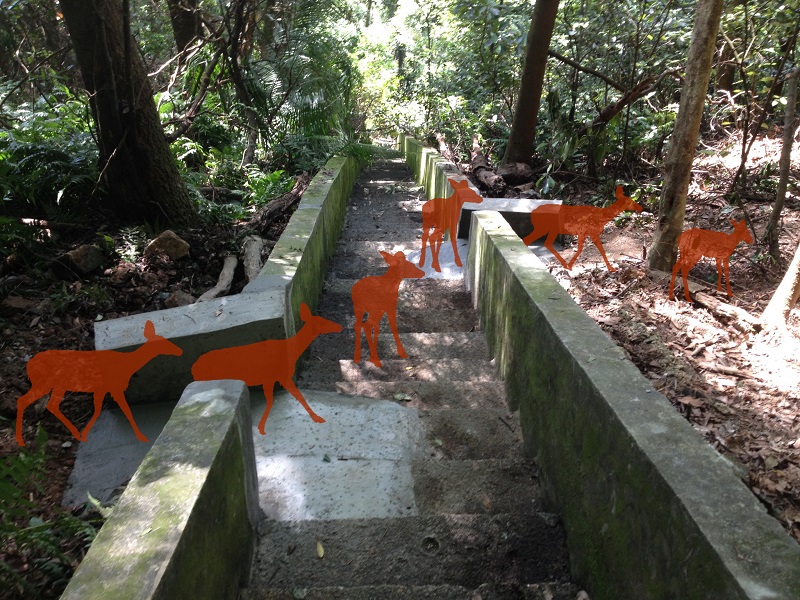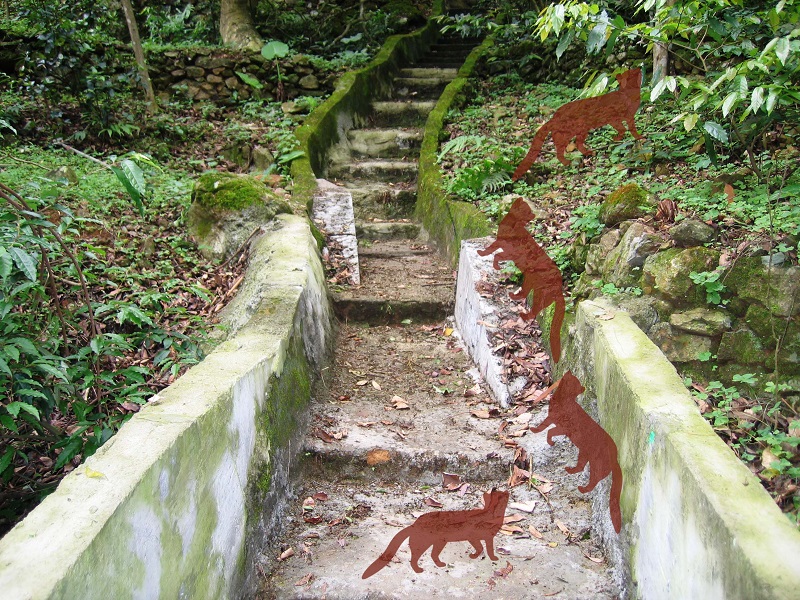Wildlife friendly city #1 “Catchments”
This is the first story in a series about transforming Hong Kong into a city that allows both humans and wildlife to thrive.

The barking deer above was discovered trapped in the water catchment on Lantau Island on 24th March. It was sent to the KFBG Wild Animal Rescue Centre and died shortly after arrival due its serious condition. Photo: Kathleen Daxon
In the space of seven weeks between March and May, six barking deer were found trapped in a stretch of catchwater on Lantau Island. However hard the ungulates (hooved mammals) tried, the slippery algae-covered walls prevented them from climbing up to safety. After workers came to their aid, one was set free unharmed, but only two of the remaining five, which were admitted to the KFBG Wild Animal Rescue Centre, made it.
Gary Ades, head of the Fauna Conservation Department, explained that trapped deer often suffer from severe stress and contract an almost always fatal medical condition known as capture myopathy. Crush syndrome in humans, which has similar results, happens when poisons build up in the muscles, after someone is crushed by a heavy object and the object is removed from the body, several organs to cease functioning and this often leads to internal complications that result in death. Therefore little can be done to save the deer when they arrive at the Rescue Centre in this condition even when they seem to be recovering.

The barking deer, found trapped in the catchment on Lantau Island on 24th March, appears to be exhausted from its escape attempts. Photo: Kathleen Daxon
The city’s 120km-long network of catchwaters, which channels the summer deluge to natural streams and reservoirs, fragments wildlife habitat and can prove fatal to unwitting wildlife ambling along the drain system, getting into the water channels looking for a drink of water, or trying to traverse the channels.
In fact, the six deer weren’t the only victims of that particular man-made watercourse on Lantau Island. Four trapped barking deer died in 2015. Cattle and snakes have also been found caught in that particular channel.
Gary says the catchment in Tai Lam Country Park is another black spot. He believes that similar accidents occur elsewhere across Hong Kong, but might have gone unreported because they are less frequented by people and animals die without their carcasses being discovered.
To fix the problem, the government built and improved wildlife-friendly features of the catchwater on Lantau Island twice in the past 14 months. The new measures include painting the sides of parts of the catchwater with anti-skid material, constructing closely spaced ledges to help trapped animals get out, and making sure both sides of that catchwater is protected by fences to prevent animals from falling in.
While KFBG is encouraged that more attention is paid to make our city’s infrastructure more wildlife friendly, we believe there is much catching up to do and there is potential for more innovative solutions to what are widespread and inconsiderate engineering designs.
For starters, we should prevent animals from falling in by installing appropriate barriers along all catchwaters, and bridges covered with gravel or turf to resemble a natural environment that encourages animals to move across.
If an animal unfortunately becomes entrapped, they should be able to find an animal friendly escape route, so they can exit with their own means without the need for rescue. Many of these catchments designed several decades ago are located in rural areas and should have flagged up the problem of animal entrapment, but clearly there was no consideration for this problem and now there is great concern among citizens that the designs are killing wildlife which is thriving due to increased protection in the countryside.

Tall concrete barriers were erected along both sides of some of the drainage channels at KFBG, openings have been created at intervals to allow animals to travel between two patches of woodland (illustrated by the artist impression). Photo: KFBG
Thus restoring grip to the sides of the catchment is paramount. We suggest to outfit the sides of the catchments with gently-sloped ramps and/or appropriately–spaced footholds could provide a more conspicuous, easily-maintained escape route for victims without obstructing water flow. These solutions should be present at regular intervals, for example, every 500m.
Ramps are the preferred design, explained Gary, because they can be accessed by all sorts of animals from slithering snakes, hopping palm-sized frogs, short-legged porcupines to 50cm-tall barking deer. While footholds are more suited for barking deer, civets and leopard cats.
Here at KFBG, we face similar engineered barriers.
A series of decades-old storm and waste water drains bisecting woodlands has posed significant barriers to wildlife. Therefore, in 2007 we started to reengineer some of our drains to address the issue.
We created openings in the drainages at certain areas as safe crossings.
 The sides of a drainage channel fitted with ramps to help trapped animals negotiate their way out. The artist impression illustrates how the animal exits the channel. Photo: KFBG
The sides of a drainage channel fitted with ramps to help trapped animals negotiate their way out. The artist impression illustrates how the animal exits the channel. Photo: KFBG
We outfitted the channels with bridges to allow animals to travel from one side of the waterway to another, and escape ramps to help trapped animals crawl back out of water. Our Facilities team also attached metal grills to road-side drainage openings that small animals were prone to falling in.
We modified some vertical gullies by providing walls of a gentler gradient that are lined with vegetation. This can give trapped wildlife better purchase on the ground and so are able to free themselves easily, while it allows some degree of soil water absorption in low flow periods but carries away heavy flood water as intended.
Gary states: “Once wildlife friendly elements are incorporated into the design of the catchment on Lantau Island, other drainage channels across Hong Kong lacking animal escape routes need to be modified. In the future, new drainage systems should be designed with wildlife in mind, and follow best practice and innovative designs already in use in other parts of the world.”

